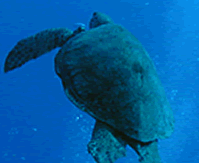
 |
||||||||||||
 |
||||||||||||
These Pups Aren’t Furry
By Charlie Hudson
Hammerhead pups aren’t what one would call cuddly, but scientists of the Hawaii Institute of Marine Biology, University of Hawaii on Coconut Island, are quite nurturing of miniature versions of sharks that will grow to nine feet or longer in adulthood. If Oahu is in your travel plans and you’ve already explored the well-known spots of Diamond Head and other points of interest listed in glossy brochures, consider contacting the Hawaii Institute of Marine Biology in Kaneohe to see if they have tours available. Their principle work is marine research and they cannot always accommodate tours, but if you have some kind of marine sciences background and will be on the island for a while, you may be able to make arrangements.
My husband and I take full advantage of Oahu’s underwater beauty, and naturally, we enjoy Sea Life Park and the Waikiki Aquarium. Not long before we were scheduled to visit some friends in Kailua, we saw a television special with a segment about shark research in Kaneohe Bay. We didn’t catch all the details, but called our hostess and asked her to inquire about tours for the public. In her usual efficient manner, she had an answer for us within a matter of days and we were lucky to be able to arrange a visit. We were warned that we might want to come early because the small parking lot fills up quickly and the only way onto Coconut Island is the small boat shuttle they operate throughout the day. What we didn’t know was that the hairpin parking lot also provides a panoramic view that deserves at least a few minutes to exhale a Wow! in appreciation.
From its origins as Moku O Lo’e, a base for local fisherman, Coconut Island in Kaneohe Bay claims a lively history. Edwin Pauley, one of several wealthy owners, established the original Hawaii Marine Lab in the early 1950s. He, and later his family and The Pauley Foundation and Trustees, contributed significantly to expand on-island research facilities and were instrumental in obtaining the remaining privately held part of the island for the University of Hawaii. For those with a keen eye and excellent memory, the island was used for a few shots in the popular television series, Gilligan’s Island. The grand houses are gone, yet as you stroll on verdant, foliaged grounds, it isn’t difficult to imagine opulent outdoor parties that were a part of Coconut Island’s social life before it was dedicated to scientific purposes. The island still retains some limited overnight accommodations that are primarily for selected staff members and temporary researchers. The island has limited overnight accommodations that are primarily for selected staff members and temporary researchers.
Scientists and students on Coconut Island have been featured in numerous magazines and cable television programs. The Hawaii Institute of Marine Biology (HIMB) provides laboratory, classroom and specialized facilities that include a flow-through sea water system, flumes simulating coral reef flat environments, reef microcosm tanks, six controlled tidal ponds, algal and larval culture facilities, solar simulators, underwater video recording and data analysis, a photographic darkroom, a room and compressor to support Self-Contained Underwater Breathing Apparatus (SCUBA) equipment, and the new Pauley-Pagen Marine Laboratory.
We were guided among the buildings and while the octopus that had squeezed itself into a section of cinderblock was interesting, our particular focus was on hammerhead shark research. We had not realized that Kaneohe Bay, a well-known birthing area for hammerhead pups, provides a reliable source for studying specimens in the wild or under more controlled conditions. We toured collection tanks where experiments are conducted and observations made, then proceeded to a series of ponds for feeding time. The ponds are six to fifteen feet deep depending on tides. Bright orange mesh-type fencing shields the outermost pond against the open bay, yet even with careful watch, the weather and curious sea creatures occasionally create holes in the fence where study subjects slip through. Conversely, several large porcupine puffers and other fish had invaded the sharks’ abode although they seemed to be peacefully co-existing with the intended marine population. Not surprisingly, the hammerhead pups were segregated from white tip and black tip reef sharks and one oceanic black tip that were in residence.
They swam languidly until the first chunk of food was tossed in and we were briefly treated to churning water and tooth-filled jaws snatching their share, but it wasn’t what you’d call a feeding frenzy.
A tour of Coconut Island is somewhat off the beaten path and there is no glitz involved. It is, however, an excellent way to see the science side of marine work, not to mention you can later say, “Why, sure I saw hammerhead sharks while I was in Hawaii.”
For more information contact The Hawaii Institute of Marine Biology P.O. Box 1346 Kaneohe, Hawaii 96744; phone (808) 236-7401, fax (808) 236-7443. You can also log onto http://www.hawaii.edu/HIMB/welcome.html for history of the island and other information. Summer tends to be the busiest months due to visiting researchers.
CH.
Copyright © 2001-2025, Charlie Hudson. All rights reserved.